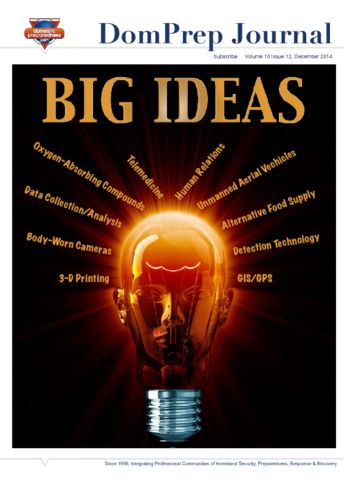

Brainstorm – 25 Concepts From Subject Matter Experts
Domestic Preparedness
December 31, 2014
When planning for its annual forecast issue, DomPrep reached out to subject matter experts in all
preparedness disciplines to share which solutions they believe have significant potential to improve
preparedness (readiness and resilience) over the next five years. In 200 words or less, more than 50
readers answered the call.

Changing the Future of Human Relations
Samuel Johnson Jr.
December 24, 2014
The “”us versus them”” mentality that has surfaced in recent news reports – in Ferguson, Missouri, New York City, and other U.S. communities – arises from the human relations divide between citizens and law enforcement officers. A simple solution exists, but it requires both “”us”” and “”them”” to redefine the social construction within communities.

Body-Worn Cameras: The Path Forward
Denise Rodriguez King and James R. (Chip) Coldren Jr.
December 17, 2014
As contradictory witness reports of police actions surface in law enforcement incidents across the
United States, the White House proposes equipping all police officers with body-worn cameras. However,
before implementing such programs, agencies first must examine related benefits and challenges, and
evaluate and review the effectiveness of these cameras as law enforcement tools.

Future Response Capabilities: Five Points to Consider
Craig Crume
December 17, 2014
With a few practical steps, state and local governments, as well as other planning and response
agencies, can accomplish a lot with little or no changes in their budgets. These agencies can build
capability, confidence, and readiness by developing concepts of operations, reviewing equipment needs,
training personnel, maintaining instruments, and regularly practicing skills.

Emerging Infectious Diseases – A Whole-Community Approach
Anthony S. Mangeri
December 16, 2014
As Ebola traveled across borders to countries not previously affected, the need for comprehensive preparedness plans became obvious. However, such cases are not simply public health threats, but whole-community incidents. As such, emergency managers must
assess emerging infectious disease threats and prepare to manage a multiagency response to these slow onset disasters.

The Future of Handheld Chemical Detection & Identification
Chris Petty
December 10, 2014
By identifying technology gaps as well as trends in detection needs and capabilities, manufacturers are creating new mass spectrometry tools that are smaller, easier to use, and more accurate for trace-level detection and identification. In 2015, first responders, civil support teams, and military personnel may be able to fill gaps left by their current equipment.

Texas – Youth Volunteers in the Medical Reserve Corps
Lunetta Sims
December 10, 2014
In Harris County, Texas, the Medical Reserve Corps (MRC) is leveraging its youth volunteers and establishing Junior MRC teams in its local high schools. By integrating a younger generation and recognizing the benefits that youth members can provide, MRCs can strengthen community preparedness and response for many years to come.

Community Paramedicine – Bringing the Hospital Home
Joseph Cahill
December 10, 2014
As hospitals fill with patients and the cost of medical care rises, the use of community paramedicine also may increase. To fill the gap between routine doctor visits and emergency transport to hospitals, communities have the opportunity to expand the use of highly trained paramedics to better serve their populations’s urgent-care needs.

Communications Decision Could Impact Emergency Response
Christina Crue
December 3, 2014
The Federal Communications Commission is considering changing the provider of the local number portability administrator. Emergency responders should be aware that this decision could affect responders’ ability to identify 911 callers, to track suspects, and to transition, test, and validate telephone databases following a disaster.

Resilience – Making a List & Checking It Twice
Stephen Grainer
December 3, 2014
When the electric power infrastructure fails, it affects much more than just the electronic equipment that is powered by it. A lesson from Superstorm Sandy demonstrates how managing ground support, supplies, and facilities may differ when electrical power is gone. It may even require hundreds (or thousands) of orange traffic cones to maintain operations.

